NCERT Solution: Electricity
According to Ohm’s law
V = IR
⇒ I=V/R … (1)
Now Potential difference is decreased to half
∴ New potential difference Vʹ=V/2
Resistance remains constant
So the new current Iʹ = Vʹ/R
= (V/2)/R
= (1/2) (V/R)
= (1/2) I = I/2
Therefore, the amount of current flowing through the electrical component is reduced by half.
The resistivity of an alloy is higher than the pure metal. Moreover, at high temperatures, the alloys do not melt readily. Hence, the coils of heating appliances such as electric toasters and electric irons are made of an alloy rather than a pure metal.
Table 12.2 Electrical resistivity of some substances at 20�C
| Material | Resistivity (Ω m) | |
| Conductors | Silver | 1.60 � 10−8 |
| Copper | 1.62 � 10−8 | |
| Aluminium | 2.63 � 10−8 | |
| Tungsten | 5.20 � 10−8 | |
| Nickel | 6.84 � 10−8 | |
| Iron | 10.0 � 10−8 | |
| Chromium | 12.9 � 10−8 | |
| Mercury | 94.0 � 10−8 | |
| Manganese | 1.84 � 10−6 | |
|
Constantan (alloy of Cu and Ni) |
49 � 10−6 | |
| Alloys |
Manganin (alloy of Cu, Mn and Ni) |
44 � 10−6 |
|
Nichrome (alloy of Ni, Cr, Mn and Fe) |
100 � 10−6 | |
| Glass | 1010 − 1014 | |
| Insulators | Hard rubber | 1013 − 1016 |
| Ebonite | 1015 − 1017 | |
| Diamond | 1012 − 1013 | |
| Paper (dry) | 1012 |
(a) Resistivity of iron = 10.0 x 10-8 Ω
Resistivity of mercury = 94.0 x 10-8 Ω
Resistivity of mercury is more than that of iron. This implies that iron is a
better conductor than mercury.
(b) It can be observed from Table 12.2 that the resistivity of silver is the
lowest among the listed materials. Hence, it is the best conductor.
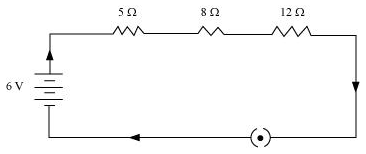
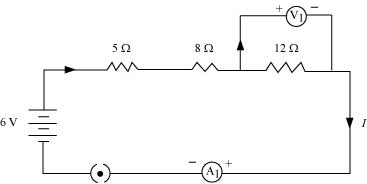
The resistances are connected in series.
Ohm’s law can be used to obtain the readings of ammeter and voltmeter. According
to Ohm’s law,
V = IR,
Where,
Potential difference, V = 6 V
Current flowing through the circuit/resistors = I
Resistance of the circuit, R = 5 + 8 + 12 = 25Ω
I = V/R = 6/25 = 0.24 A
Potential difference across 12 Ω resistor = V1
Current flowing through the 12 Ω resistor, I = 0.24 A
Therefore, using Ohm’s law, we obtain
V1 = IR = 0.24 x 12 = 2.88 V
Therefore, the reading of the ammeter will be 0.24 A.
The reading of the voltmeter will be 2.88 V.
Let R be the equivalent resistance.
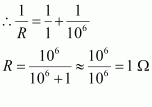
Therefore, equivalent resistance ≈ 1 Ω
(b) When 1Ω, 103 Ω and 106 Ω are connected in parallel:
Let R be the equivalent resistance.

Therefore, equivalent resistance = 0.999 Ω
Resistance of toaster, R2 = 50 Ω
Resistance of water filter, R3 = 500 Ω
Potential difference of the source, V = 220 V
These are connected in parallel, as shown in the following figure.
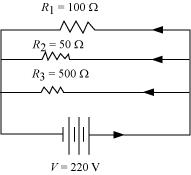
Let R be the equivalent resistance of the circuit.
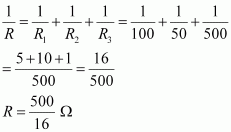
According to Ohm's law,
V = IR
![]()
Where,
Current flowing through the circuit = I

7.04 A of current is drawn by all the three given appliances.
Therefore, current drawn by an electric iron connected to the same source of
potential 220 V = 7.04 A
Let R' be the resistance of the electric iron. According to Ohm's law,

Therefore, the resistance of the electric iron is 31.25 and the current flowing through it is 7.04 A.
There is no division of voltage among the appliances when connected in parallel. The potential difference across each appliance is equal to the supplied voltage.
The total effective resistance of the circuit can be reduced by connecting electrical appliances in parallel.